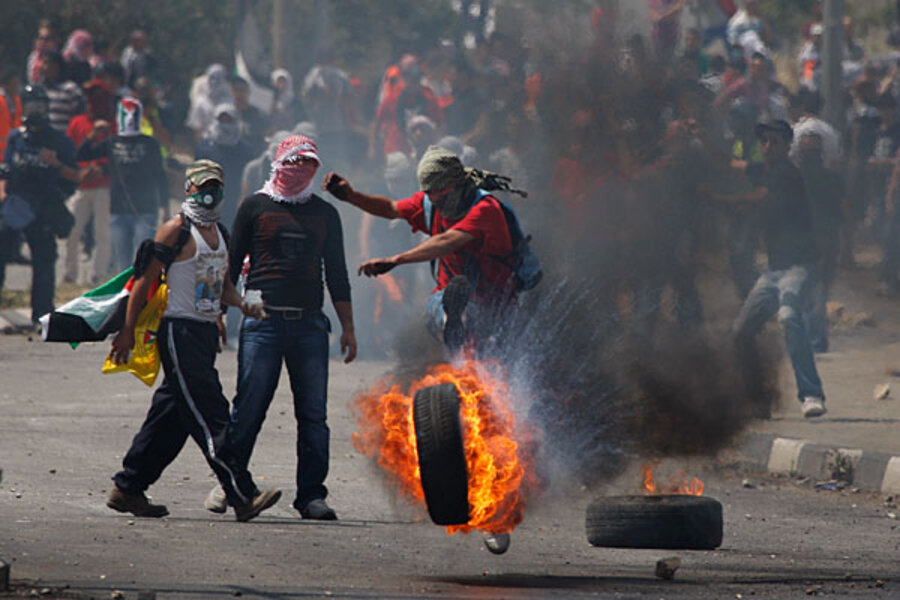Palestinians mark Nakba Day with slingshots, despite calls for calm
| Ofer Prison, West Bank
Palestinian protesters marking Nakba Day clashed with Israeli soldiers in the West Bank today injuring at least 70, despite attempts from Palestinian leaders to avoid violence and a recent deal with Israel to end a prison hunger strike.
Nakba or “catastrophe,” marks the day the state of Israel was created and caused the exile of hundreds of thousands of Palestinians, most of whom remain refugees in countries such as Lebanon, Syria, and Jordan.
Many analysts expected calm today, as a result of last night’s deal, in which most of some 2,000 Palestinians on hunger strike in Israeli jails quit their fasts, in exchange for concessions from the Israeli prison service to improve jail conditions.
But instead, clashes erupted between Palestinian youth and Israeli soldiers near the prison, highlighting anger among some who felt the deal was too weak and should have released more prisoners. While the deal moved many prisoners out of isolation and will allow family visits for prisoners from Gaza, there was no commitment from Israel to end the practice of holding Palestinians without charge.
“My son Rami is in there,” says Rizek Fadayel, a refugee who fled from Jaffa in modern day Israel and lives in Ramallah in the occupied West Bank, pointing behind him toward the prison complex. “He was given six months, but maybe they will give him six more.”
Hoping to avoid confrontation, the Palestinian Authority (PA) organized Nakba events in the center of Ramallah, far from flash points with Israel. On a large stage in the recently renamed Yasser Arafat Square, musicians performed for a crowd of flag-waving Palestinians, some hoisting each other on their shoulders.
In Gaza, Hamas held a marathon – seen as attempt by the militant group to avoid confrontation with Israel – and even Hamas leader, Ismail Haniyeh, participated.
But for many young Palestinian activists, marathons and peaceful protest was not how they wanted to commemorate the day. Crowds of young people launched rocks from slingshots at Israelis soldiers who responded with a barrage of tear gas and sprayed the crowd with a skunk cannon, which soaked the crowd with foul smelling liquid, in an attempt to disperse protesters.
“I’m against these events and dancing in Ramallah today,” says 21-year-old Amir Hemly, holding a handful of broken cement readied as ammunition outside Ofer prison. “If they want to dance, they should come and dance here. In Ramallah they are not doing anything. We are showing the Israelis we are here to stand against them.”
While such protests usually take place at the Qalandia checkpoint between Ramallah and Jerusalem, the biggest protest today was at Israel’s Ofer military prison, the site of a large-scale hunger strike, reflecting the Palestinians continued support of the prisoners' movement and the dissatisfaction of some with the agreement. But protesters also gathered at the Qalandia checkpoint between Ramallah and Jerusalem, at Rachel's Tomb in Bethlehem, and in Arab towns inside Israel.
While Palestinians continue to air grievances against endemic detention and the ongoing occupation, Mark Regev, a spokesperson for the Israeli Prime Minister, says their anger on this day is misdirected.
“I would say to those protesters, ‘Why are we not celebrating in parallel?’” says Mr. Regev, blaming the Palestinian leaders' refusal 64 years ago to accept partition of the British Mandate for their continued statelessness. “They should be protesting against their own leadership.”
Over all, the protests were calmer than last year’s Nakba Day events, which saw hundreds of Palestinian refugees storm Israel’s borders from Lebanon and Syria, resulting in at least a dozen deaths and more than 100 injuries.






